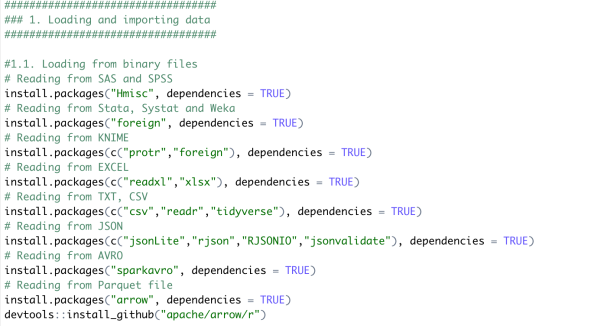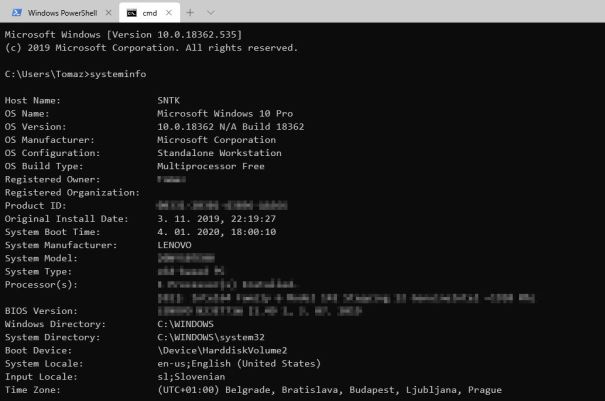
Articles by tomaztsql
Quine with R
Quine is a self-reproducing function or a computer program that will output its source source or itself. Terms used are for these programs are also self-replicating programs, self-reproducing programs or self-copying programs (courtesy of wikipedia). Many programming languages have been…Read more ›

Essential list of useful R packages for data scientists
I have written couple of blog posts on R packages (here | here ) and this blog post is sort of a preset of all the most needed packages for data science, statistical usage and every-day usage with R. Among…Read more ›

Custom Power BI visual for Line chart with two Y-Axis
Power BI support certain type of visuals that are by default available in the document. These are absolutely great and work perfectly fine, have a lot of capabilities to set properties and change the settings. But every so often in…Read more ›

What and who is IT community? What does it take to be part?
This blog post is long over due and has been rattling in my head for long time. Simply and boldly put it, community is everyone involved behind the result of your search for a particular problem. And by that I…Read more ›
[Read more...]
The palindrome of 02.02.2020
As of writing this blog-post, today is February 2nd, 2020. Or as I would say it, 2nd of February, 2020. There is nothing magical about it, it is just a sequence of numbers. On a boring Sunday evening, what could…Read more ›

Sudoku game with R
Sudoku is a classical logical game based on combinatorial number replacement puzzle. Objective is to to fill 9×9 matrix with digits so that each column, each row, and each box (3×3 sub-grid) of nine contain all of the digits from…Read more ›

Working with Windows CMD system commands in R
From time to time, when developing in R, working and wrangling data , preparing for machine learning projects, it comes the time, one would still need to access the operating system commands from/in R. In this blog post, let’s take…Read more ›

Advent of Code 2019 challenge with R
I have decided to tackle this year’s Advent Of Code using R (more or less). I know there are more preferred languages, such as Python, C#, Java, JavaScript, Go, Kotlin, C++, Elixir, but it was worth trying. Into the 8th…Read more ›

Hangman game with R
Hangman is a classic word game in which you need to need to guess as many possible letters in word, so you can guess the word, before running out of tries (lives). Upon running out of tries, you are hanged!…Read more ›

Finding duplicates in data frame across columns and replacing them with unique values using R
Suppose you have a dataset with many variables, and you want to check: if there are any duplicated for each of the observation replace duplicates with random value from pool of existing values. In this manner, let’s create a…Read more ›

Creating data frame using structure() function in R
Structure() function is a simple, yet powerful function that describes a given object with given attributes. It is part of base R language library, so there is no need to load any additional library. And also, since the function was…Read more ›

Number 6174 or Kaprekar constant in R
Not always is the answer 42 as explained in Hitchhiker’s guide. Sometimes it is also 6174. Kaprekar number is one of those gems, that makes Mathematics fun. Indian recreational mathematician D.R.Kaprekar, found number 6174 – also known as Kaprekar constant…Read more ›

Installing R using Powershell
Installing R from scratch and creating your favorite IDE setup is especially useful when making fresh installation or when you are developing and testing out different versions. This blogpost will guide you through some essential steps (hopefully, there will not…Read more ›

Window Aggregate operator in batch mode in SQL Server 2019
So this came as a surprise, when working on calculating simple statistics on my dataset, in particular min, max and median. First two are trivial. The last one was the one, that caught my attention. While finding the fastest way…Read more ›

Running R scripts within in-database SQL Server Machine Learning
Having all the R functions, all libraries and any kind of definitions (URL, links, working directories, environments, memory, etc) in one file is nothing new, but sometimes a lifesaver. Using R function source is the function to achieve this. Storing…Read more ›

First release and update dates of R Packages statistics
R has been around long time and the packages have evolved through the years as well. From the initial releases, updates, to new packages. Like many open-source and community driven languages, R is not an exception. And getting the first…Read more ›

SQL Server 2017 Machine Learning services with R book
Yes, I am finally blogging this. ? This blog post is slighty different, since it brings you the tittle of the book, that my dear friend Julie Koesmarno (blog | twitter) and I have written in and it was published…Read more ›

Real-time data visualization using R and data extracting from SQL Server
In the previous post, I have showed how to visualize near real-time data using Python and Dash module. And it is time to see one of the many ways, how to do it in R. This time, I will not…Read more ›

R null values: NULL, NA, NaN, Inf
R language supports several null-able values and it is relatively important to understand how these values behave, when making data pre-processing and data munging. In general, R supports: NULL NA NaN Inf / -Inf NULL is an object and is returned when an expression or function results in an undefined value. ...

Copyright © 2025 | MH Corporate basic by MH Themes